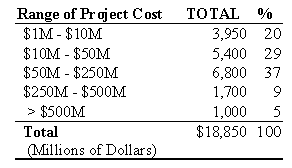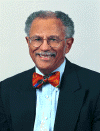|
Opinion- 29May 2003 |
|
Mapping Science and Engineering Infrastructure and Beyond |
The United States' National Science Board updated its report on Science and Engineering Infrastructure for the 21st Century: The Role of the National Science Foundation last month. In its Forward it states, "The report presents the findings and recommendations developed by the task force and approved unanimously by the National Science Board [and is] based on a study conducted by the National Science Board (NSB). [It] aims to inform the national dialogue on the current state and future direction of the science and engineering (S&E) infrastructure. It highlights the role of the National Science Foundation (NSF) as well as the larger resource and management strategies of interest to Federal policymakers in both the executive and legislative branches."
For a PDF
version of the complete report (1.3 Mbytes)
click here.![]()
The importance the NSB places on adequate infrastructure for science and engineering and the role it sees for the National Science Foundation is shown in its preamble to the report's executive summary:
The degree to which infrastructure is regarded as central to experimental research is indicated by the [eight physics] Nobel Prizes awarded for the development of new instrument technology [d]uring the past twenty years.
Among Federal agencies, NSF is a leader in providing the academic community with access to forefront instrumentation and facilities. Much of this infrastructure is intended to address currently intractable research questions, the answers to which may transform current scientific thinking. ...it is imperative that NSF's infrastructure investments provide the maximum benefit to the entire S&E community. NSF must be prepared to assume a greater S&E infrastructure role for the benefit of the Nation. ...there is an urgent need to increase Federal investments to provide access for scientists and engineers to the latest and best S&E infrastructure, as well as to update infrastructure currently in place.
The report, goes to pains to define infrastructure and comes up with, "infrastructure not only includes tools but also provides the basis, foundation, and/or support for the creation of tools."
The NSB concludes its introductory chapter with:
On numerous occasions, drafts of the report were presented to and discussed with the NSF Director's Policy Group, the NSB Committee on Programs and Plans, and the full National Science Board.
The draft report was then released for public comment on the NSB/INF Web site. Many comments were received. Feedback from a wide range of sources was carefully considered in producing the final draft of this report, which was unanimously approved by the NSB on February 6, 2003.
The report is both telling and forthright with regard to problems in the United States that pertain to research infrastructure within universities.
Maintaining the academic research infrastructure in a modern and effective state over the past decade has been especially challenging because of the increasing cost to construct and maintain research facilities and the concomitant expansion of the research enterprise, with substantially greater numbers of faculty and students engaged in S&E research.
The problem is exacerbated by the recurrent Federal funding of research below full economic cost, which has made it difficult for academic institutions to set aside sufficient funds for infrastructure maintenance and replacement. A recent RAND study estimated that the true cost of facilities and administration (F&A) for research projects is about 31 percent of the total Federal grant. Because of limits placed on Federal F&A rates, the share that the Federal Government actually pays is between 24 percent and 28 percent. This share amounts to between $0.7 billion and $1.5 billion in annual costs that are not reimbursed. Moreover, the infrastructure component in negotiated F&A rates has increased since the late 1980s, from under 6 percent in 1988 to almost 9 percent in 1999.
And while saying that determining what universities need for science and engineering infrastructure is "a difficult and complex task" and decided that "Conducting a new comprehensive survey of academic institutions was not deemed to be practical, in that it would take too much time to accomplish. As an alternative, the [Task force on Science and Engineering Infrastructure] engaged in a number of parallel activities designed to assess the general state and direction of the academic research infrastructure and illuminate the most promising future opportunities. The principal activities were the following:"
The INF surveyed the current literature, including reviewing and considering the findings of more than 60 reports, studies, and planning documents. Representatives from other agencies, such as NASA, DoE, OMB and the Office of Science and Technology Policy (OSTP) made presentations to the INF and responded to many questions. In addition, specialists were invited to address the task force on relevant topics at several meetings.
The seven NSF directorates and the Office of Polar Programs (OPP) provided assessments of the current state of the research infrastructure serving the S&E fields they support, as well as an assessment of future infrastructure needs and opportunities through 2010. Senior staff in these organizations also made presentations and supplied additional material to the task force and frequently attended its meetings.
On numerous occasions, drafts of the report were presented to and discussed with the NSF Director's Policy Group, the NSB Committee on Programs and Plans, and the full National Science Board.
The draft report was then released for public comment on the NSB/INF Web site. Many comments were received. Feedback from a wide range of sources was carefully considered in producing the final draft of this report, which was unanimously approved by the NSB on February 6, 2003.
The upshot of their analyses is a table of NSF future infrastructure needs (US millions of $) for the decade 2003-2012.

It will be interesting to compare the approach taken by the NSB and its recommendations to the much more broadly scoped review "Mapping Australia's Science and Innovation System" currently underway by the Department of Education, Science and Training.
While the "Mapping Exercise" is
directed not to make recommendations, it is enjoined to "identify the key
issues in Australia's science and innovation system: 1.strengths which
should be maintained and developed; 2.weaknesses and gaps in science and
innovation performance which need to be addressed; 3.complementarities
and areas of possible greater cooperation on Commonwealth and State/Territory
government activities."
On the face of it, the task force detailed to undertake this mission has a mammoth assignment before it. Just what will be the utilization of its findings is difficult to gauge, particularly were there a change in head of government before the next election, and baring in mind the Coalition's reluctance to provide significant resources or incentives to bring Australia near to the top rung of OECD countries.
 The Chair of the National Science Board, Warren Washington, sums up the importance of research and engineering infrastructure succinctly: Experimental and observational research depends upon the quality of the infrastructure and the tools that are accessible to the researcher. Modern tools provide more coverage, more precision and more accuracy for experiments and observations. Indeed, some modern tools open experimental vistas that are closed to those lacking modern infrastructure and tools. |
Alex Reisner
The Funneled Web